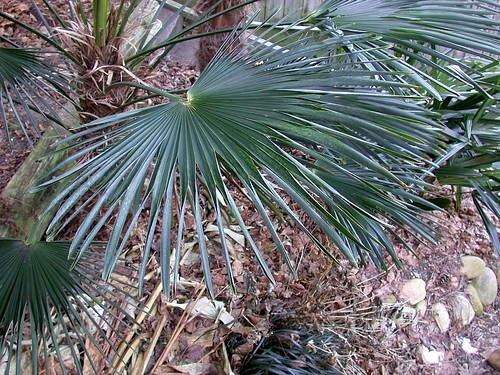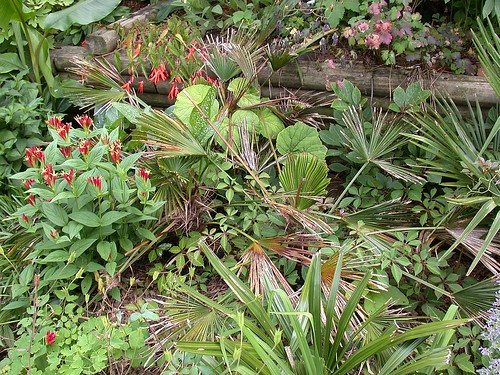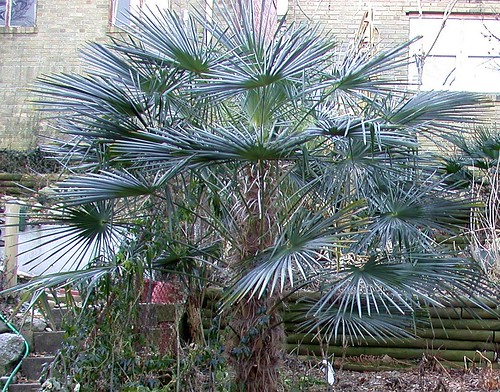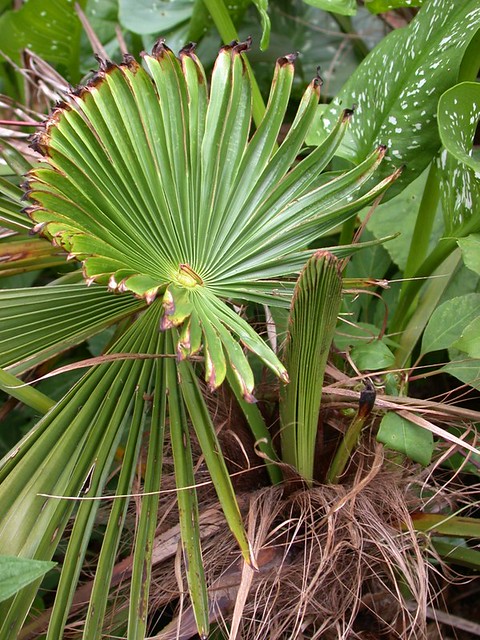
Curled leaflets on a Trachycarpus wagnerianus frond at 5.2 degrees
After several days of practically apocalyptic forecasts, I spent last night listening to the wind and wondering just how cold it would get. After a rainy and fairly warm morning, at around 5:00 pm the wind had picked up, the temperature started dropping rapidly, and by this morning, local airports had recorded our area's lowest temperatures since 1996. At 8 am, the official low temperature at DCA (Washington National Airport) was 7° F (-13.9° C) but in my own back yard, the temperature was 5.2° F (-14.9° C), the coldest I've had since buying this property in December 2000. The next coldest I've recorded was 6° F (-14.4° C) in January 2004.
Temperatures like this are bad news for palms, especially when combined with wind. Signs of damage are immediate, in particular folded and curling leaflets with a "freeze-dried" silvery look from the exposed undersides (above). I've seen this before, in January 2009 when several of my palms suffered serious damage after a low of 8° F. That was the first time my "waggies" (Trachycarpus wagnerianus) had their spears* pull, and nearly all their leaves fried as well. This is how they looked in June 2009--not a pretty sight:

I was amazed that this did not kill them. All 3 of them put out new growth by early summer and recovered somewhat but went into winter considerably weakened. Despite warmer temperatures two of them suffered further damage the following winter and died early the next year. The one survivor has done very well since then, but the winters since 2009 have also been quite a bit warmer!
Today's daytime temperatures stayed well below freezing and are going to drop again tonight. I won't know how extensive the damage is until temperatures go above freezing, sometime tomorrow afternoon; if the leaflets remain folded and freeze-dried looking, the damage is likely permanent and irreversible, and the frond will die. The full extent of the damage will only be apparent by spring, when the dead fronds begin to turn brown and dry up, and when spears are likely to pull.
Showing similar cold stress is my "Bulgarian" windmill palm, which is supposedly a particularly hardy strain. This palm has done quite well in my garden, and has had its spear pull only once, also in January 2009, but with minimal damage otherwise and recovering quickly afterwards.

Trachycarpus fortunei "Bulgarian" at 5.2 degrees
Another winter like 1993-94, the last time temperatures in Washington, DC fell below zero degrees, is likely to kill most or all of the windmill palms in the area. But where these extreme weather events are fairly infrequent, many gardeners consider it worthwhile to grow marginally hardy plants like palms, even though we know that sooner or later we'll get a winter that will knock them down. With good siting, good care, and a bit of luck, windmill palms have the potential to last 15-20 years or more in the DC area, making it worth the risk to at least some of us.
One good thing about windmill palms is that they can and do recover from spear pull, even massive defoliation, and fairly quickly at that. In the meantime the palms look like hell, which may limit their use in public plantings where plants are expected to look good! In private gardens, this damage can be tolerated until it grows out. Inexperienced palm growers may think their palms are dead, but they should be given until at least mid-summer, when new growth is likely to emerge.
My only windmill palm that has never had its spear pull, and has always shown the least damage to the foliage, is my T. fortunei "Nainital" (which for some reason I didn't photograph this morning). Originally misidentified as T. takil, this has proven to be a very hardy, very vigorous, and very fast-growing selection of the species.
And of course Fatsia japonica is doing its famous "fatsia flop", but I know from past experience that these will recover without any damage as soon as temperatures go above freezing. Note the immature fruits; I've gotten ripe fruits 4 out of the last 6 years but temperatures below the mid-teens kill the fruits, which otherwise remain on the plant over the winter and ripen in the spring but only after relatively mild winters.

Fatsia japonica at 5.2 degrees
*The "spear" of a palm is the emerging leaf, with the leaflets still tightly folded up. The spear is visible in this photo of a recovering waggy, with the leaflets just beginning to unfold:
Trachycarpus wagnerianus, recovering from winter damage


Ouch! Hopefully the cold spell you're having there won't last long and your palms will be fine, who knows it may not even spear pull this time. In contrast we had around 3-4 Trachycarpus that were defoliated by fire and much to our surprise they recovered. Tough palms they are
ReplyDeleteThanks, now that it has warmed up a bit I'm seeing signs of permanent damage but I won't know how extensive it is until spring. Even if they suffered major damage I don't think it was cold enough to kill my palms so I expect them to come back.
DeleteAfter a radiational low of 1 and an advective low of 3 or 4, I'm getting variable results with trachys. I'll be posting pics and info as damage becomes more pronounced.
ReplyDeleteSteve, your lows were comparable to what people in DC's outer suburbs experienced--probably not cold enough to kill most palms but definitely cold enough for major damage. At those temperatures even a degree or two can make a big difference. I'm definitely interested in finding out how your own palms fared!
Delete7F here in Atlanta. Even the ground froze. This was not cool.
ReplyDeleteTrue, but temperatures were warm enough before this freeze that the ground wasn't frozen going into it, and it warmed up pretty rapidly afterwards, so I'm hopeful that the ground didn't freeze deeply.
Delete